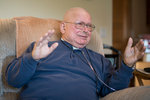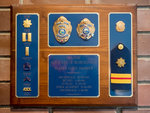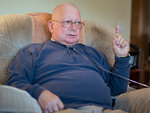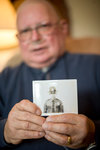




Years ago on a cold New Year’s Eve, Michael Korhonen was left at home to care for his younger brother.
His parents’ house sat on the edge of a disreputable area in Juneau, Alaska. As the evening grew longer, he fell asleep on the couch. A drunk man stumbled into the house and into his parents’ bed, where he fell asleep. Alone with his brother, Korhonen did not know what to do.
“My mom and dad came back and of course all hell breaks loose,” he said. “They call the city police and the city policeman showed up and took this bad guy away. That was such an impressive thing on me as a young child. … I know that’s what it was that was my motivation to get me started.”
That happened when Korhonen was in fourth grade, and he later wrote a class essay on why he wanted to become a police officer.
With his motivation to help people, he created a lifelong career, becoming the first cadet officer in the state of Alaska just two days after he graduated high school.
He continued climbing through the ranks. At 21 he was commissioned to be a sergeant and a year later became an Alaska State Trooper, graduating first in his class. From there Korhonen worked in Anchorage and later transferred to Bethel where he and one other trooper were in charge of 96,000 square miles. With no radios, only one patrol van and a dog team, Korhonen and his partner worked 24 hours a day, seven days a week keeping the 15 communities safe.
The job was demanding, with no office and no secretary to answer phone calls. Their spouses helped relay incoming calls.
This was just the beginning of a career that was recently recognized in Alaska. Korhonen received the Fraternal Order of Alaska State Troopers’ Lifetime Achievement Award, an honor for which only four others have been recognized.
Through countless awards and recognitions over the years, Korhonen said this one was different.
“I had a lot of things done in my career, but this is unique,” he said.
Two of the five recognized have since passed away and Korhonen is happy to carry on the legacy.
“The two that are gone are just the backbone of Alaska law enforcement and the State Troopers. To be included in that is very special. I’m kind of overwhelmed,” he said.
Korhonen changed the face of Alaska law enforcement during his years, developing a 24-hour emergency trauma training program, becoming the first state breathalyzer expert and instructor and developing municipal police training academies, as well as contributing to the original training program for the Village Public Safety Officer program. He was the state’s only Shoot No Shoot instructor for many years and improved the EMT program. Korhonen helped bring the automated fingerprint system online in Alaska before the FBI began using it, and spent 12 years teaching at the academy, being promoted from corporal to captain in charge of the training academy in Sitka. He was instrumental in bringing a new state-of-the-art crime laboratory to the state and also spent many years as the officer in charge of police training in Micronesia with the U.S. Department of the Interior.
Throughout his time, Korhonen saw the department advance and change in ways that are almost unimaginable. He went from working with no radio, to seeing the newest technologies take over the law enforcement realm.
‘A Nasty, Tragic Wreck’
Korhonen’s rewarding career featured its share of tribulations. In June of 1967 he was involved in an airplane crash, barely escaping with his life. Three U.S. Coast Guard members, including the captain and the co-captain, were killed during the crash, while Korhonen and two others were able to escape with their lives.
“It was a nasty, tragic wreck,” he said.
Before the crash Korhonen was sent on a search and rescue mission in search of the Commissioner of Education, an amateur airplane pilot, who had been reported overdue.
Korhonen remembers the plane flying into an extreme mountainous area when the trouble began. The plane went into a valley and did not have the power to fly out, ultimately hitting a 4,000-foot cliffside at 2,500 feet.
“I still experience nightmares from time to time. We go into the forest and the trees are clipping over the wings of the airplane and then we smash into the cliff,” Korhonen said, with tears filling his eyes.
The plane was traveling at 150 miles per hour at the time of impact and skidded 13 feet.
“We went from 150 to zero in 13 feet,” he recalled. “When they finally found the three guys that were killed, they were buried four feet in the ground.”
Korhonen’s hips were ripped out of his sockets and his ribs on the right side were pulled off of his sternum.
With time ticking down and gasoline dissipating through the airplane’s cabin, Korhonen pulled one survivor to safety before the wreckage caught fire.
“There’s no reason we should have survived that,” he said. “That was my escape of death.”
The memory is strong and vivid in his mind, as are the arrests of some of Alaska’s most notorious murderers. He helped track and apprehend dozens of wanted men, even playing a role in the capture of Robert “the Butcher Baker” Hansen, an American serial killer who kidnapped, released and later hunted strippers in Alaska’s bush.
Human Interaction
Korhonen doesn’t base his career’s success on its on-paper highlights. To him, it went back to the scared little boy he was in the house on New Years Eve; the human aspect is what made his job worthwhile.
“It’s the human things that you remember,” Korhonen said, staring off into the distance collecting his thoughts. “The feeling that I wanted to have like when that guy came to my house; the terribly tragic things are the things that stick in my mind. They were little things in terms of (my career), not huge earth-shaking events.”
He recalled one of the most impactful moments of his career. A Coast Guard couple had left to go kayaking for the day when the weather turned bad. Neither returned, leaving their young boy with no parents. Korhonen remembers going to sit with the little boy. At that time Alaska law enforcement officers had a distinctive tie tack, a short pin used to attach the end of a necktie to a shirt front.
“I pinned my tie tack on him and he really liked that,” Korhonen said, his eyes full of tears. “Those were the times that you remember in a career that have absolutely nothing to do with the career. It’s that human interaction and that’s when you’re satisfied with what you’ve done.”
Cancer: 18 Months To Live
Korhonen has lived a life full of achievement, a life that is soon to end because of lung cancer. He was given only to Christmas to live, but thankfully the chemotherapy started working and now Korhonen has 18 months to live.
“When you compare 18 months to Christmas, that’s a big difference,” he said.
Korhonen plans to continually be involved with Alaska law enforcement until the end. For the last 19 years he has hosted an annual reunion at his home in Chehalis out on Logan Hill Road.
“If I live, I will (host it again), but I probably won’t,” he said.
He aims to stay around long enough to host one more reunion, and to be able to ride his motorcycle one last time. For now, he’s focusing on his six-year-old granddaughter, a girl he wants to spend the most time with.
Even with his personal goals, Korhonen knows he will always be involved in Alaska’s law enforcement. Through his 24-year-long career as a state trooper, he has impacted the direction law enforcement has taken, a debt the Fraternal Order of Alaska State Troopers will forever be grateful for.
“I consider this every day that I’m still involved actively as a state trooper,” he said.